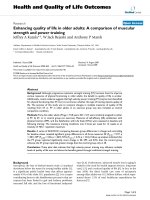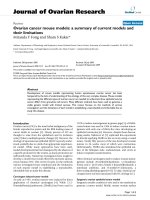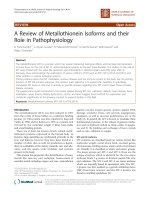- Trang chủ >>
- Khoa Học Tự Nhiên >>
- Vật lý
Exercises in quantum mechanics; a collection of illustrative problems and their solutions 2nd rev edition
Bạn đang xem bản rút gọn của tài liệu. Xem và tải ngay bản đầy đủ của tài liệu tại đây (9.84 MB, 346 trang )
w
w
w
w
Exercises in Quantum Mechanics
www.pdfgrip.com
Kluwer Texts in the Mathematical Sciences
VOLUME 6
A Graduate-Level Book Series
The titles published in this series are listed at the end of this volume.
www.pdfgrip.com
Exercises in
Quantum Mechanics
A Collection of Illustrative Problems
and Their Solutions
Second Revised Edition
by
Harry Mavromatis
Department of Physics,
King Fahd University of Petroleum and Minerals,
Dhahran, Saudi Arabia
Springer-Science+Business Media, B.V.
www.pdfgrip.com
Library ofCongress Cataloging-in-Publication Data
"CIP-data available from the Publisher on request."
ISBN 978-94-010-5172-9
ISBN 978-94-011-2652-6 (eBook)
DOI 10.1007/978-94-011-2652-6
Printed on acid-free paper
AlI Rights Reserved
© 1992 Springer Science+Business Media Dordrecht
Originally published by Kluwer Academic Publishers in 1992
Softcover reprint ofthe hardcover lst edition 1992
No part ofthe material protected by this copyright notice may be reproduced or
uti1ized in any form or by any means, electronic or mechanical,
including photocopying, recording or by any information storage and
retrieval system, without written permission from the copyright owner.
www.pdfgrip.com
To:
Vasso
and
To:
Anthony and Blanche
Tn f.p.a un f.uTiv
www.pdfgrip.com
Table of Contents
Preface
Preface to Second Edition
Schematic Illustration
Chapter 1
Chapter 2
Chapter 3
Chapter 4
Chapter 5
Chapter 6
Chapter 7
Chapter 8
Chapter 9
Chapter
Chapter
Chapter
Chapter
Chapter
Chapter
Chapter
Chapter
Index
10
11
12
13
14
15
16
17
IX
Xl
Xlll
Wilson-Sommerfeld Quantization Condition
The Delta Function, Completeness, and Closure
Momentum Space
Wavepackets and the Uncertainty Principle
Uncertainty Principle and Ground-State Energies
of Quantum-Mechanical Systems
Free Particles Incident on Potentials, Time Delay,
Phase Shifts, and the Born Approximation
Heisenberg Representation
Two-, Three-, and N-, Versus One-Dimensional
Problems
'Kramers' Type Expressions, The Virial Theorem,
and Generalizations
Upper Bounds and Parity Considerations
Perturbation Theory
Degeneracy
The Inverse Problem
The Dalgarno-Lewis Technique
Angular Momentum and Coupled States
Tensor Operators, and Evaluation of Matrix Elements
Applications of Quantum Mechanics
www.pdfgrip.com
1
16
34
47
68
74
102
111
124
133
157
186
214
227
262
291
312
326
Preface
This monograph is written within the framework of the quantum mechanical
paradigm. It is modest in scope in that it is restricted to some observations and
solved illustrative problems not readily available in any of the many standard (and
several excellent) texts or books with solved problems that have been written on
this subject. Additionally a few more or less standard problems are included for
continuity and purposes of comparison.
The hope is that the points made and problems solved will give the student
some additional insights and a better grasp of this fascinating but mathematically
somewhat involved branch of physics.
The hundred and fourteen problems discussed have intentionally been chosen to
involve a minimum of technical complexity while still illustrating the consequences
of the quantum-mechanical formalism.
Concerning notation, useful expressions are displayed in rectangular boxes while
calculational details which one may wish to skip are included in square brackets.
Beirut
June, 1985
HARRY A. MAVROMATIS
IX
www.pdfgrip.com
Preface to Second Edition
More than five years have passed since I prepared the first edition of this monograph.
The present revised edition is more attractive in layout than its predecessor, and
most, if not all of the errors in the original edition (many of which were kindly pointed
out by reviewers, colleagues, and students) have now been corrected.
Additionally the material in the original fourteen chapters has been extended with
significant additions to Chapters 8, 13, and 14.
Three new chapters, Chapters 15-17 were added in order to make this volume more
comprehensive and more complete in its coverage of Elementary Quantum Mechanics,
principally by including material on angular momentum coupling and tensor algebra.
As a result of these additions and the revisions of the original fourteen chapters, the
present monograph includes 228, as opposed to the 114 solved exercises in the first
edition.
The author would like to acknowledge the support of the King Fahd University
of Petroleum and Minerals in this project.
Harry A. Mavromatis
Dhahran
October, 1991
Xl
www.pdfgrip.com
Schematic illustration of
various approaches to
calculating Energy Levels
of
Quantum Mechanical Systems
Energy Levels:
Approach for
High-lying States:
Generally useful
approaches:
1) Wilson-Sommerfeld
Quantization Condition
(Chapter 1)
1) Schrodinger equation
in Momentum Space
(Chapter 3)
2) Poles of Scattering
Amplitude
(Chapter 6)
3) Schrodinger equation
in Coordinate Space
(Chapters 8, 9, 12, 16)
4) Perturbation Theory
(Chapter 11)
Approaches for Ground State:
1) Uncertainty Principle
(Chapter 5)
5) Dalgarno-Lewis
Technique
(Chapter 14)
2) Variational Technique
(Chapter 10)
Xlll
www.pdfgrip.com
CHAPTER 1
Wilson-Sommerfeld Quantization Condition
The hydrogen atom, when treated using Bohr's admixture of classical and quantum concepts involves an electron circulating about a proton (subject to the attractive
Coulomb force - (e 2 147rfor2) r) in orbits which satisfy the condition:
27rr = nADe Broglie,
n = 1, 2, 3 ....
Since ADe Broglie = hlp this reduces to p27rr
the Wilson-Sommerfeld quantization condition:
f
pdq
= nh
n
= nh, which may be generalized to
= 1, 2, 3...
(1.1)
,
where § implies a complete cycle, and p and q are conjugate variables.
'By construction' Eq. (1.1) gives the correct quantized energies for the hydrogen
atom. But it also gives the correct energy spectrum for a particle in a box with
infinite walls:
V(x) = {
0,
00,
0< x < a,
x < 0, x> a.
EXAMPLE 1.1
Find the energy levels for a particle in a box with infinite walls:
V(x) = {
0,
00,
0< x < a,
x < 0, x> a.
In the region 0 < x < a, E = p2/2m.
Hence Eq. (1.1) in this case becomes
f .J2mEdx = nh
where a cycle involves x varying from 0 --7 a and from a
Integrating one obtains:
2a.J2mE = nh
or
--7
O.
n 2 h2
E = - 82 ' n = 1, 2, 3 ....
ma
www.pdfgrip.com
(1.2)
Chapter 1
2
By contrast the quantum-mechanical treatment of this problem involves solving
the Schrodinger equation:
"liZ dZ
2m dxz
[-
+ V(x) ] 'I/;(x)
(1.3)
= E'I/;(x),
V( xl
~----
______
o
~
____________ x
a
Figure 1.1: Potential in Example 1.1.
for 0 < x < a with boundary conditions '1/;(0), 'I/;(a) = 0, 'I/;(x) being zero for
x < 0, x> a.
The properly normalized eigenfunctions of Eq. (1.3) which satisfy these boundary
conditions are:
(:2
'I/;(x)=V~
sinkx
with
Thus
'1/;(0) =
and
'I/;(a) =
If
sinka = 0
ka=mr, where
If
if
k
"li 2 2
2m =E.
sinO = 0,
ka = mr,
while
www.pdfgrip.com
n = 1, 2, 3... ,
Wilson-Sommerfeld Quantization Condition
3
by construction.
Since
this implies
exactly the result Eq. (1.2).
One can gain a little more insight as to the range of applicability of the WilsonSommerfeld quantization condition by studying slightly more complicated systems.
EXAMPLE 1.2
Find the energy levels of a particle in the potential:
0,
V(x)=
1
Vo, a
(Assuming E >
0< x < a,
x
< 0,
x
> a + b.
Vo which corresponds to the interesting case.)
V( x)
Vo
~~----------~--------------~--------x
a
o+b
Figure 1.2: Potential in Example 1.2.
www.pdfgrip.com
Chapter 1
4
The Wilson-Sommerfeld quantization condition can be immediately applied to
this case:
a+b
fa
2 10 PI dx + 2 a P2 dx = nh
l
where
PI
= hkl = J2mE,
P2
= hk2 = V2m(E - Vo)
I.e.
( 1.4)
On the other hand, solving the Schrodinger equation in the regions 0 < x < a
and a < x < a + b ('IjJ(x) being zero for x:::; 0, x ~ a + b) yields
0 < x < a,
'IjJ(x) = AsinkIx,
'IjJ(x)=Bsink2(x-a-b),
a
since 'IjJ(0) and 'IjJ(a + b) must be zero.
The continuity of 'IjJ(x) , d'IjJ(x)jdx at x = a then implies
kl
tan kl a = - k2 tan k2b.
(1.5)
One notes that the conditions specified in Eq. (1.4) and Eq. (1.5) are different. Only if k2 rv kl i.e. E > > Vo that is if the total energy is large compared to
the potential energy does Eq. (1.5) reduce to Eq. (1.4) since then tan kla rv - tan k2b
which is satisfied if
kla + k2b = mr,
n = 1, 2, 3 ....
A second example which illustrates the range of applicability of the WilsonSommerfeld quantization condition is the finite square-well problem.
EXAMPLE 1.3
Find the energy levels for a particle in a square well
vwhere E
<
{
0,
Ixl > a,
-IVoI, Ixl < a,
o.
www.pdfgrip.com
Wilson-Sommerfeld Quantization Condition
5
The kinetic energy
p2
T = -
2m
=
IVoI - lEI
for
Ixl < a.
The Wilson-Sommerfeld quantization condition therefore yields in this case
l.e.
(1.6)
v (x)
o
-0
----------------.---------r--------.---------------- - - - - - - - - - - - - - - - 1 - - - - - -lEI
x
T
L---_ _
+--_~
t -IVol
Figure 1.3: Potential in Example 1.3.
On the other hand, solving the Schrodinger equation in the regions
a yields respectively
Ix I >
1/Je(x) = Acoskx
Ixl <
a,
Ixl < a, 1/Je(x) = Bexp{-Klxl} Ixl > a,
where
_J2m EI
l
k=
K-
~'
or
1/Jo(x)
=
Asinkx
(where the subscripts e,
x
---+
0
Ixl < a, 1/Jo(x) = ±Bexp {-Klxl}
x~
± a,
stand for even and odd solutions under the interchange
-x.)
www.pdfgrip.com
Chapter 1
6
The continuity of 'l/J'f,(x) and d'l/J'f,(x)/dx at x = ± a (independently for the odd
and even solutions) implies:
tan ka =
and
cot ka =
K
(even solution),
k
( 1.7)
k
(odd solution).
As in the previous example, Eq. (1.6) and Eq. (1.7) are not identical. Only if the
total energy is large compared to the potential energy, i.e. IVoI » lEI
(since these quantities are negative) i.e. K/k -+ 0 do they agree, since then
tanka =
0
cot ka =
0
and
or
ka =
n7r
2'
i.e. ka = {
7r,27r ...
7r /2, 37r /2 ... ,
n = 1, 2, 3... ,
yielding
I.e.
which is identical to Eq. (1.6).
Though the Wilson-Sommerfeld quantization condition was superseded by Quantum Mechanics (with the Schrodinger and Heisenberg formulations in the early twenties), as a calculational aid it has the advantage over the Schrodinger equation that it
is easier to work with since it involves an integral rather than a differential equation.
However, as indicated in Examples 1.2-3, it generally gives results which are reasonably accurate (i.e. in agreement with Quantum Mechanics) only when the energy is
large compared to the potential under consideration.
If V(x) = Alxl P one can obtain the form of the energy sequence according to the
Wilson-Sommerfeld quantization condition Eq. (1.1) as follows:
can be written (for En
> 0)
as
www.pdfgrip.com
Wilson-Sommerfeld Quantization Condition
7
Hence
or generally:
lEn I = n 2p /(p+2)
where
AII/Ph
{ I
n = 1, 2, ... (p
V2m I(p)
f -Iul du
I(p) = f Vlul
du
I(p) =
and
}2P/(P+2)
)1
(1.8)
if En > 0,
p
P -
> -2),
1
if
En
<
o.
As p - t 00, En in Eq. (1.8) becomes ex n 2 , the result Eq. (1.2) for a particle in a
box with infinite walls. [In detail 1(00) =4, E(X> = n 2Aoh 2/32m = n 2h 2 /32m. This
corresponds to a = 2 in Eq. (1.2), i.e. V = 0, Ixl < 1, V = 00, Ixl > 1.]
In several cases I(p) can be easily evaluated directly.
EXAMPLE 1.4
Find the energy levels for a particle in the well
V(x) = Ax2,
-00
<
X
<
00,
using the Wilson-Sommerfeld quantization condition.
If p = 2 Eq. (1.8) reduces to
En = n
(
A
2m
)1/2
h
1(2) ,
where
l.e.
En =
n'hlff., n=
1, 2, 3 ....
(1.9)
This result can be compared to the familiar Schrodinger equation result:
(1.10)
www.pdfgrip.com
Chapter 1
8
EXAMPLE 1.5
Find the energy levels for a particle in the well:
VeX) =
{ AX2,
x> 0,
x
00,
< 0,
using the Wilson-Sommerfeld quantization condition.
This problem goes through like Example 1.4, except
1(2) = 2
and hence
En =
1
1
o
1r
~ du = -
2
2nhV{2A
-;;;:,
n = 1, 2, 3 ... ,
(1.11)
as opposed to the Schrodinger equation result:
En =
(2n -
Dhfg,
n= 1, 2, 3....
(1.12)
EXAMPLE 1.6
Find the energy levels for a particle in the well
Vex) = Alxl, all x (A> 0).
Here p = 1 and Eq. (1.8) reduces to:
E - n2/3
(
n -
where
1(1) = 4
Ah
2/3
y'2r;i"1(1)
1 vr=x
1
o
)
,
8
dx = -,
3
l.e.
n
=
1, 2, 3....
(1.13)
as compared to the solution of the Schrodinger equation (see Eq. (3.31) ) for this
problem in the limit of large En namely:
En
= {n - ~r/3
1/3
(A~2) c~r/3,
www.pdfgrip.com
n= 1, 2, 3....
Wilson-Sommerfeld Quantization Condition
9
EXAMPLE 1.7
Find the energy levels for a particle in the well
Alxl, x
V(x) = {
> 0 (A> 0),
x <
00,
o.
This problem goes through as in Example 1.6 except
1(1) =
210 vT=X dx =
1
4/3,
and hence
_ 2/3 (A21i,2)1/3 (~)2/3
En - n
/0
m
2v2
n = 1, 2, 3... ,
'
(1.14)
as compared to the solution of the Schrodinger equation (see Eq. (3.18)) for this
problem in the limit of large En namely:
EXAMPLE 1.8
Find the energy levels for a particle in the well:
IAI
V(x) = -~'
Here p = -1 and E <
all x.
o. Thus
where
1( -1) =
410 J~ - 1 du = 27r,
1
I.e.
E __ 2mlAI2 1
n 1i,2
n2
'
(1.15)
which is identical to the energy levels obtained for this problem using the Schrodinger
equation (see Eq. (3.32) ).
www.pdfgrip.com
Chapter 1
10
EXAMPLE 1.9
Find the energy levels for a particle in the well:
V(x) = {
-IAI/x, x> 0,
x < O.
00,
One proceeds as in Example 1.8 except
1(-1) =
210 J~ -1 du =
1
7[",
and hence
n = 1, 2, 3 ... ,
(1.16)
which is identical to the energy levels obtained for this problem using the Schrodinger
equation (see Eq. (3.23) ).
EXAMPLE 1.10
Find the energy levels for a particle in the well
V(x) = AlxI 1/ 2 ,
Here p = 1/2,
Thus
all x.
and E > O.
E - n 2/ 5 {
n -
A2h
V2rri 1(1/2)
}2/5
,
where
1.e.
En = n 2/ 5 (
A2h 15
V2rri
2m 32
)2/5 '
n = 1, 2, 3....
EXAMPLE 1.11
Find the energy levels for a particle in the well:
V(x) = {
Ax1/2, x> 0,
00,
x < O.
One proceeds as in Example 1.10 except
www.pdfgrip.com
(1.17)
Wilson-Sommerfeld Quantization Condition
11
I.e.
n = 1, 2, 3 ....
(1.18)
EXAMPLE 1.12
Find the energy levels for a particle in the well:
V(x) =
Here p = -1/2 and
Thus
E
IAI
-lxI 1/ 2
all x.
'
E < O.
- n- 2 / 3 {
I nl-
IAI-2h
}-2/3
.,fiiTi 1(-1/2)
n
,
= 1, 2, 3, ... ,
where
1.e.
En = _n- 2 / 3
IAI- 2h) -2/3
( .,fiiTi
7r
,n =
1, 2, 3 ....
(1.19)
EXAMPLE 1.13
Find the energy levels for a particle in the well:
V(x) =
{
-IAlx-l/2, x> 0,
x
00,
(E < 0)
< O.
One proceeds as in Example 1.12 except
1(
-~) = 2101 VU- 1/ 2 -
1.e.
_
-2/3
En - -n
Generally
I(p)
=
=
f VI -Iul
p
du =
1 du =
(IAI-22h)
-2/3 ,
.,fiiTi
2m
7r
4101 viI -
n = 1, 2, 3 ....
uP du =
~ 101(1 -
W)1/2 w {1!P)-1
(1.20)
dw
( 1.21)
±B (~
p
i'
~) _ 2v1iT ( {I / p} + 1 )
2' p - r( {1/p} + {3/2} ) .
www.pdfgrip.com
Chapter 1
12
EXAMPLE 1.14
Find the energy levels for a particle in each of the following wells:
Vi(x) = Ax 1 / 3 ,
V2(x) = Ax 1 / \
ltJ(x) = AX 1/ 5 ,
all x,
using Eq. (1.21).
From Eq. (1.21): I(1/3) = 64/35, I(1/4) = 512/315, I(1/5) = 1024/693.
Hence
A3h 35 }2/7
{
(1.22)
En(P = 1/3) = n2/7...;2m
,
2m 64
E ( = 1/4) = n2/9 { A4h 315 }2 / 9
n P
...;2m 512
'
(1.23)
E (p = 1/5) = n2/11 { A5h 693 }2/11
n
...;2m 1024
(1.24)
The results of Example 1.4-14 are summarized in Table 1.1.
For two-dimensional systems (or three-dimensional systems where a particle moves
in a plane chosen for convenience to be the x-y plane), where the potential only
depends on p,
P~
E = -2
m
f
Hence
P~
+ -mp
22 + V(p).
P¢ de/> = n¢h,
which implies
P¢
(1.25)
n¢ = 1, 2, 3 ... ,
(1.26)
= n¢n,
and
fpp dp= nph,
I.e.
f
np = 1, 2, 3 ... ,
2mE - (n¢h)2 - 2mV(p) dp = nph,
p2
np = 1, 2, 3... .
(1.27)
(1.28)
The integral in Eq. (1.28) can be evaluated analytically for certain problems.
EXAMPLE 1.15
Find the energy levels for a particle of mass m in the potential
www.pdfgrip.com
Wilson-Sommerfeld Quantization Condition
13
TABLE 1.1
Energy levels for various potentials Vex)
p
Range
1
x ;:: 0
1
-00
-00
-00
1/2
00
00
x;:: 0
1/2
-00
x;::o
-1/2
-1/2
-00
1/3
-00
1/4
-00
1/5
-00
n
= n 2/3 ( A2/;2
)1/3 ( 3". )2/3
m
2T2
< x < 00 E n = n 2/3 ( A2/;2
m
x;::o
-1
-1
E
x;::o
2
2
Wilson-Sommerfeld
quantization condition
472 y/3
3 ( 3".
Schrodinger result
En
= (n _ 1)2/3
( A2/;2t3( 311: y/3
4
m
2T2
(for large E)
E n = (n
(for large E)
= 2n C~) 1/2 ~
A~) 1/2 -1h:
E n = (~2n- -2\) (--2m
En
= n (A~f/2
!l
2m
En
= (n - t)
!l
2 (:Ay/2
2m
".
En
= _n- 2(!n;:t_)
En
= _n- 2(m;~2_)
En
= _n- 2(?m~tI2_)
E n -- -n -2 (?mltI2_)
Ii.
'7r
(A
h15;r/5
,~
2
2 h15 r / 5
E n -- n 2/5 (A
i
,Fm32
2 2hJ- 2/ 3
E n = _n- 2/3(lAI,Fm"";
< X < 00 En -__ n -2/3 (~)-2/3
2m ".
- 2/7 (A h35i )2/7
< X < 00 E n-n
,~,
3
315 )2/9
< X < 00 E n = n 2/9 CA4h
2m 512i
< X < 00 E n = n 2/11
(V2m
ASh 1024
693 ) 2/7
www.pdfgrip.com
t
_ 1)2/3
311: 3
m
472
2 ( A2/;2t3(
En
E n-n
- 2/5
00
r/
= AlxlP









